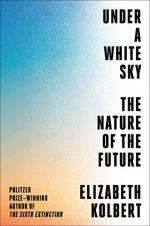
|
| Name: _________________________ | Period: ___________________ |
This test consists of 15 multiple choice questions and 5 short answer questions.
Multiple Choice Questions
1. What is wrong with the Wood Screw Pumps in the twenty-four pumping stations that pump water out of the city?
(a) They are not effective at keeping out water.
(b) They are speeding up the sinking of the city.
(c) Many are broken and need to be fixed.
(d) They are difficult to replace.
2. What two events sped up the drop in pupfish numbers?
(a) Over-crowding of species and an overgrown fungus.
(b) An earthquake and drought.
(c) Regular above ground nuclear blasts and the pumping of water for a new community.
(d) Rising sea levels and air temperatures.
3. What happens if coral is unable to acquire new symbionts after a heatwave?
(a) They begin to shrink.
(b) They turn white.
(c) They starve to death.
(d) They grow lonely.
4. What book does Kolbert say led to the introduction of Asian carp in U.S. rivers?
(a) How to Control Non-Native Species.
(b) The evils of Pesticides.
(c) Rachel The Control of Nature.
(d) Fish Are Our Friends.
5. When Manly and the others arrived at the edge of Death Valley, what did they think the fish were that they saw swimming in the cavern pool?
(a) Pupfish.
(b) Goldfish.
(c) Minnows.
(d) Carp.
6. What had those living in the Plaquemenes done to protect their homes after Hurricanes Katrina and Rita?
(a) Sunk them deep into the mud.
(b) Converted their homes into house boats.
(c) Lifted them up onto pilings.
(d) Torn them down and moved elsewhere.
7. To what island does Kolbert compare desert ecosystems?
(a) The Arctic.
(b) Galápagos.
(c) The Great Plains.
(d) The Amazon.
8. What does bleaching do to coral?
(a) It kills the coral.
(b) It causes it to become brittle.
(c) It breaks down the relationship between coral and their symbionts.
(d) It detaches the symbionts from the coral.
9. In Down the River Chapter 1, what examples of metaphors does Elizabeth Kolbert give involving rivers?
(a) Rivers are metaphors for depth, reflection, and life.
(b) Rivers are metaphors for loneliness.
(c) Rivers are metaphors for all the problems that humans have caused.
(d) Rivers are metaphors for pollution, destruction, and decay.
10. When Kolbert visits the United States Army Corps of Engineers’ location in Chicago soon after her cruise down the sewage canal, she meets with whom?
(a) The engineer in charge of cleaning the sewage canal.
(b) The engineer in charge or rerouting the river.
(c) The engineer in charge of the electric fish barriers.
(d) The engineer in charge of the levees.
11. What is a NOT a technique listed by Kolbert to support species that were brought back from the brink of extinction?
(a) Supplemental feeding.
(b) Managed burns.
(c) Catch and release.
(d) Captive breeding.
12. By the time 2016’s global bleaching event ended in 2017, what percentage of the Great Barrier Reef was affected?
(a) Over 50%.
(b) Over 75%.
(c) Over 90%.
(d) Just under 90%.
13. After a disastrous flood in what year, did the Army Corps of Engineers extend the levees?
(a) 1920.
(b) 1917.
(c) 1827.
(d) 1927.
14. Why were low-lying parts of New Orleans not abandoned to the water?
(a) It was not necessary.
(b) The locals fought to save their property.
(c) After the most recent hurricanes, they recovered on their own.
(d) It did not make sense politically.
15. What is NOT something that Kolbert says human domination over nature has caused?
(a) Large amounts of nitrogen and carbon dioxide.
(b) Earthquakes.
(c) Dammed and diverted rivers.
(d) More species diversity and safer drinking water.
Short Answer Questions
1. How much of the Caribbean coral disappeared in the 1980s?
2. What does Kevin Irons, the assistant chief of fisheries at the Illinois Department of Natural Resources, feel is the best way to control the carp population?
3. What act led to the introduction of Asian carp?
4. In Kolbert’s observations in and near Chicago, Asian carp, when caught, are then processed into what?
5. How does Kolbert feel about the community of Isle de Jean Charles?
|
This section contains 668 words (approx. 3 pages at 300 words per page) |

|




